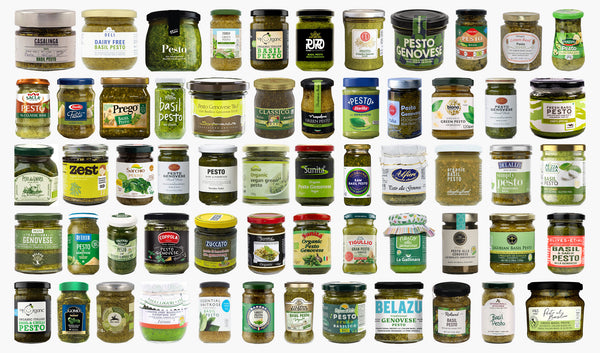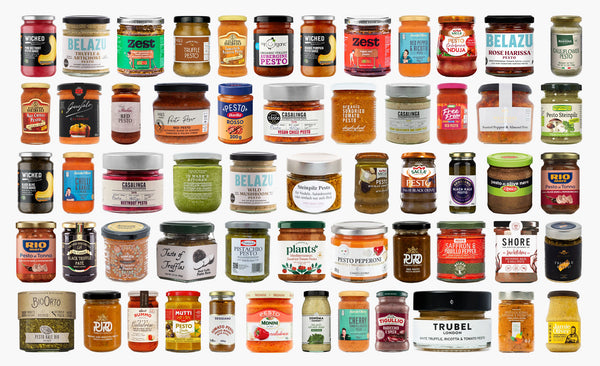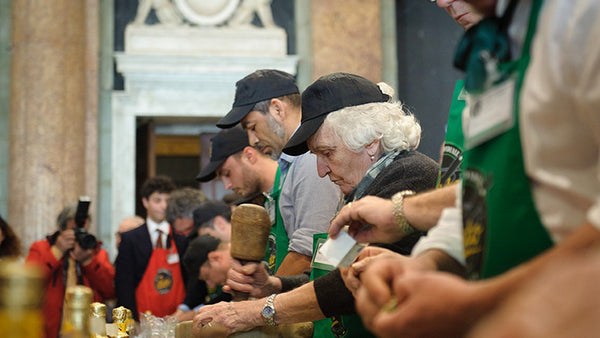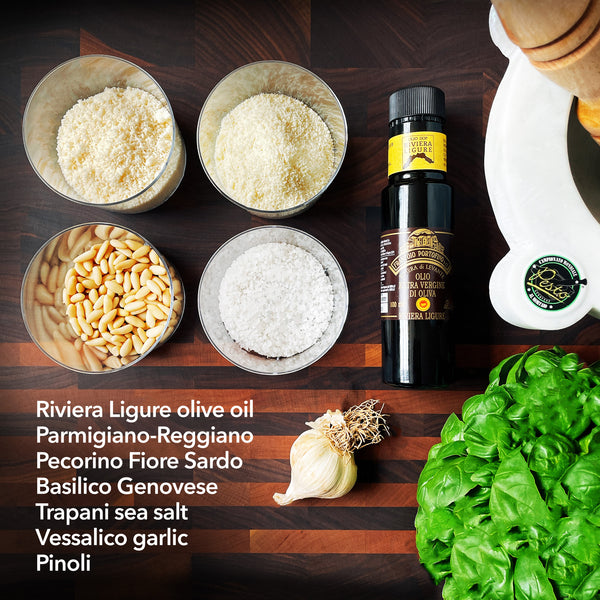The Official Basil Pesto Recipe

Jump to the official recipe
Jump to our simplified recipe
The World's Most Authentic Pesto
The only pesto recipe recognised by the Pesto Genovese Consortium contains just seven ingredients: basil, olive oil, pine nuts, Parmigiano-Reggiano, pecorino, garlic, and salt. EU law protects many of the ingredients from inferior copycats. Here, we're publishing the legendary recipe that rewards you with the most delicious and authentic pesto outside Liguria.

How Many Pesto Recipes Are There?
Supermarkets may make you think that the potential for new and exciting pestos is practically limitless. In some ways that is true, but it's not a view held by the members of the Pesto Genovese Consortium, who maintain that their recipe is the only one worthy of the name.
The Italians' Love of Pesto Genovese
Pesto Genovese is the official name of the classic basil pesto we all know and love. It's one of the world's greatest sauces, so it's no wonder that the people of Genoa, the recognised birthplace of pesto, hold it dear to their hearts. It's hard to emphasise the passion in the region for their 'green gold', although the beautiful local adage nicely sums it up that pesto is the second thing a Genovese baby tastes after its mother's milk.

A quick online search throws up hundreds of sauces that purport to be classic basil pesto. Their ingredients, however, vary wildly. Some producers chase cost savings by switching expensive ingredients like extra-virgin olive oil and pine nuts for cheaper alternatives like sunflower oil and cashews. Some use flavourings like basil extract to improve their sauce's taste, while others contain acidity regulators to prolong shelf life. At the bottom of the barrel, you will find sauces containing all kinds of nasties, like egg lysozyme, potato flakes, and refined soya.
The Rise of Alternative Pesto Recipes
Variations in the recipes of different shop-bought, basil-based pestos are just the tip of the iceberg. Widen your search, and you will find thousands of sauces marketed as pesto that contain unconventional ingredients such as beetroot, seaweed, and salami.

Producers of these sauces argue that imitation is the sincerest form of flattery and that it's only natural for food lovers to experiment with recipes and bring new ideas. For traditionalists, though, this form of appropriation is seen as disrespectful to Genoa's cultural heritage.
You may assume that because Italians are so proud of their pesto, only foreign imposters would dare ride on the coattails of its reputation to produce such renegade sauces. Nothing could be further from the truth. Seggiano's pesto line-up includes aubergine, kale, and fennel. Sacla produces truffle, coriander, and red pepper pestos. Meanwhile, the world's biggest pasta producer, Barilla, uses tomato puree, sugar, and balsamic vinegar in one of their most popular pesto products.
The Genovese Want Their Pesto Back
While the Genovese don't claim to have invented pesto, Genoa and the broader region of Liguria are where the classic basil pesto recipe we know today was honed and perfected.
Over the years, regional producers have become increasingly appalled at the plethora of sauces flooding the market that claim to be pesto but are virtually unrecognisable from the classic recipe. In 2006, Ligurian farmers and pesto producers successfully protected their recipe from inferior copycats by proving that the region's basil is so unique that it deserves protection under EU law. That means that Basilico Genovese has a 'protected designation of origin' status, which acts as proof of both quality and provenance.

Some people in the region want the European Union to protect not just their basil but pesto itself. If granted, this protection would ban any company from calling their sauce 'pesto' unless it followed a precise recipe, used an exact production method, and included ingredients sourced from specific geographical locations.

Efforts to Keep the Traditional Pesto Recipe Alive
Most producers accept that pesto is now such a mainstream product that legally protecting it is highly unlikely. Instead, a group of businesspeople and gourmets set up the Palatifini Cultural Association and created the Pesto World Championships to celebrate and promote the original recipe to a global audience.
In the lead-up to the biennial competition, delegates are sent to countries worldwide to judge heats and select the best pesto maker in their country. In a lavish ceremony at the Doge's Palace in the heart of Genoa, 100 finalists compete to make the best pesto using only the seven allowed ingredients. The event generates plenty of publicity and is seen as a vital way to keep the traditional recipe alive and in people's minds.

The Official Basil Pesto Recipe
Sourcing the ingredients required to make a genuine basil pesto is undeniably tricky. Your best bet is the premium Italian food importer Eataly, which has shops in several capital cities, including London, Paris, and Stockholm. Everyone else must make a few compromises, so we're accompanying this recipe with a simplified version. We've also given some recommendations for substitute ingredients. Both recipes will make enough pesto for 4-6 servings.
| Ingredient | Quantity |
| Riviera Ligure olive oil (PDO) | 65g |
| Genovese basil (PDO) | 60g |
| Pisa pine nuts | 30g |
| Parmigiano-Reggiano (PDO) | 30g |
| Pecorino Fiore Sardo (PDO) | 20g |
| Vessalico garlic | 1 clove |
| Trapani sea salt | pinch |

Our Simplified Basil Pesto Recipe
While this recipe may not be entirely authentic, using the finest ingredients you can afford will result in a pesto far superior to anything available in the supermarket.
| Ingredient | Quantity |
| Olive oil | 65g |
| Basil | 60g |
| Parmesan | 50g |
| Pine nuts | 30g |
| Garlic | 1 clove |
| Salt | pinch |
Substitute Ingredients
Oil
Cold-pressed extra virgin olive oil is famed for its flavour, aroma, health benefits, and the fact that it hasn't undergone extensive processing. For these reasons, we urge you to spend a little extra on the good stuff, but even regular olive oil will make your sauce far superior to one made from cheaper neutral oils like vegetable oil or canola oil.
Don't assume that all extra virgin olive oils are equal. The official pesto recipe dictates that it must come from the Italian Riviera, where the oil is famed for having moderate fruitiness and tiny bitter and spicy notes prevalent in oils from other regions. A good delicatessen can help you choose the most similar oil, but if all else fails, stick to the generic stuff in the supermarket. Big supermarket chains don't generally cater to foodies, so they tend to sell generic products that are not imbued with any award-winning character but won't offend their customers with potentially divisive flavours.
Basil
Basil is exceptionally prone to bruising and does not travel well, so getting hold of Genovese basil outside Liguria is almost impossible. However, if you buy a fresh basil plant (the sweet variety, not Thai basil) and use only the smallest leaves, you'll get close enough to the real deal.
Pine nuts
Pine nuts from China are cheaper than those from the Mediterranean but have a notable downside. For some people, eating them can result in a condition called 'pine mouth', which causes a lingering metallic aftertaste lasting for weeks. It's simply not worth the risk. Sunflower or pumpkin seeds make decent alternatives if you can't afford pine nuts.
Cheeses
The official basil pesto recipe calls for pecorino and Parmigiano-Reggiano, but these cheeses vary greatly in sharpness, saltiness, and intensity. Rather than ruining your pesto by choosing the wrong cheese, stick to generic Parmesan. You can also use Grana Padano as a substitute.
Garlic
While different varieties of garlic have slightly different flavour profiles, the intensity of their taste is much more affected by the way you process them than the specific variety. Chop garlic cloves with a knife for a mellow flavour, or grate them if you want them to be so spicy that you'll think you've been assaulted.
Salt
The official pesto recipe specifies Trapani salt from Sicily, which is easy to find online but may not justify the added cost. Instead, use high-quality sea salt flakes rather than heavily processed table salt. Not only will the flavour be superior, but the coarse texture of the flakes will also help break down the garlic as you grind it.

How to Make Pesto
For complete authenticity, pesto should be made with a pestle and mortar—not for nostalgia, but because pounding and crushing the ingredients extracts more essential oils and volatile flavours than slicing them with a food processor's blades.
If you don't own a pestle and mortar or can't be bothered with the hassle, an electric blender or food processor will do. Just make sure to add the oil by hand at the end because processing it at high speeds can turn it bitter.
Start by half-slicing a single garlic clove and discarding the green "germ" running down the middle, if it has one. Add the garlic to the mortar with a generous pinch of salt and crush it thoroughly until it breaks down into a smooth paste.
Add the pine nuts and rotate the pestle around the sides of the mortar to create a paste.
When you have completely broken down the nuts, add the basil leaves, ideally using the smallest ones, as they taste extra sweet. Continue working the sauce for another minute or two until you reach a smooth consistency.
Add the cheese, work the sauce for another minute, and then slowly drizzle in the olive oil until the sauce is silky and super creamy.
Have a taste, and add some extra salt or garlic if needed.

How to Serve Pesto
Pesto is best served immediately to prevent the herbs from oxidising and dulling the sauce's flavour. However, it will last three days without excessive deterioration in the fridge.
Pesto and pasta are two of gastronomy's great love affairs. If you've made your pesto, it would be a disservice to serve it with poor-quality pasta. Therefore, we always recommend opting for bronze-die pasta if your budget allows, or better yet, making it yourself from scratch.
If you want to experience what the inhabitants of Liguria have been eating pesto, try pairing your sauce with traditional pasta shapes, such as trofie, trenette, or corzetti. Pesto is a proudly raw sauce, so it doesn't need to be heated in anything other than the residual heat of the pasta. Cooking destroys all those amazingly fresh flavours you've put so much effort into encapsulating.
Pesto's Life Beyond Pasta
While pesto will forever be synonymous with pasta, there are plenty more strings to its bow, not just as a topping for pizza or bruschetta. Here, we've compiled a handy guide to using pesto.
